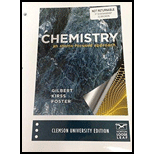
To find:
The enthalpy changes (
Answer to Problem 9.91QA
Solution:
a)
b)
c)
Explanation of Solution
1) Concept:
For
2) Formula:
Positive values of
3) Given:
The required average bond energy values are taken from Table A4.1 of Appendix 4.
| Bond | Bond energy (kJ/mol) |
| H-H | |
| N-H | |
| N-N | |
| N=N | |
| N=O |
4) Calculations:
a) The given balanced reaction is
The reaction involves the formation of two moles of ammonia from its constituent elements in their standard states.
First, we have to draw the Lewis structures of reactants and products into the balanced chemical equation to get the number of bonds involved in each reactant and product.
![]() +
+ ![]() ⤍
⤍ ![]()
We can construct a table using the appropriate bond energies:
| Bonds | Number of bonds(mol) | Bond energy kJ/mol | ||
| Bonds broken | ||||
| Bonds broken | ||||
| Bonds formed |
We can get the value of
b) The given balanced reaction is
The reaction involves the formation of one mole of hydrazine from its constituent elements in their standard states.
First, we have to draw the Lewis structures of reactants and products into the balanced chemical equation to get the number of bonds involved in each reactant and product.
![]() +
+ ![]() ⤍
⤍ 
We can construct a table using the appropriate bond energies:
| Bonds | Number of bonds(mol) | Bond energy (kJ/mol) | ||
| Bonds broken | ||||
| Bonds broken | H-H | |||
| Bonds formed | N-N | |||
| Bonds formed | N-H |
We can get the value of
c)The given balanced reaction is:
The reaction involves the formation of two moles of nitrous oxide gas from its constituent elements in their standard states.
First, we have to draw the Lewis structures of reactants and products into the balanced chemical equation to get the number of bonds involved in each reactant and product.
![]() +
+ ![]() ⤍
⤍ ![]()
We can construct a table using the appropriate bond energies:
| Bonds | Number of bonds(mol) | Bond energy (kJ/mol) | ∆H | |
| Bonds broken | 2 | 945 | ||
| Bonds broken | 1 | 498 | ||
| Bonds formed | N=N | 2 | 418 | |
| Bonds formed | N=O | 2 | 607 |
We can get the value of
Conclusion:
The standard enthalpy change of a reaction can be calculated using the standard average bond energies per mole for each reactant and product.
Want to see more full solutions like this?
Chapter 9 Solutions
Chemistry: An Atoms-Focused Approach
- What is the final product when hexanedioic acid reacts with 1º PCl5 and 2º NH3.arrow_forwardWhat is the final product when D-galactose reacts with hydroxylamine?arrow_forwardIndicate the formula of the product obtained by reacting methyl 5-chloro-5-oxopentanoate with 1 mole of 4-penten-1-ylmagnesium bromide.arrow_forward
- The temperature on a sample of pure X held at 1.25 atm and -54. °C is increased until the sample boils. The temperature is then held constant and the pressure is decreased by 0.42 atm. On the phase diagram below draw a path that shows this set of changes. pressure (atm) 2 0 0 200 400 temperature (K) Xarrow_forwardQUESTION: Answer Question 5: 'Calculating standard error of regression' STEP 1 by filling in all the empty green boxes *The values are all provided in the photo attached*arrow_forwardpressure (atm) 3 The pressure on a sample of pure X held at 47. °C and 0.88 atm is increased until the sample condenses. The pressure is then held constant and the temperature is decreased by 82. °C. On the phase diagram below draw a path that shows this set of changes. 0 0 200 temperature (K) 400 аarrow_forward
 ChemistryChemistryISBN:9781305957404Author:Steven S. Zumdahl, Susan A. Zumdahl, Donald J. DeCostePublisher:Cengage Learning
ChemistryChemistryISBN:9781305957404Author:Steven S. Zumdahl, Susan A. Zumdahl, Donald J. DeCostePublisher:Cengage Learning ChemistryChemistryISBN:9781259911156Author:Raymond Chang Dr., Jason Overby ProfessorPublisher:McGraw-Hill Education
ChemistryChemistryISBN:9781259911156Author:Raymond Chang Dr., Jason Overby ProfessorPublisher:McGraw-Hill Education Principles of Instrumental AnalysisChemistryISBN:9781305577213Author:Douglas A. Skoog, F. James Holler, Stanley R. CrouchPublisher:Cengage Learning
Principles of Instrumental AnalysisChemistryISBN:9781305577213Author:Douglas A. Skoog, F. James Holler, Stanley R. CrouchPublisher:Cengage Learning Organic ChemistryChemistryISBN:9780078021558Author:Janice Gorzynski Smith Dr.Publisher:McGraw-Hill Education
Organic ChemistryChemistryISBN:9780078021558Author:Janice Gorzynski Smith Dr.Publisher:McGraw-Hill Education Chemistry: Principles and ReactionsChemistryISBN:9781305079373Author:William L. Masterton, Cecile N. HurleyPublisher:Cengage Learning
Chemistry: Principles and ReactionsChemistryISBN:9781305079373Author:William L. Masterton, Cecile N. HurleyPublisher:Cengage Learning Elementary Principles of Chemical Processes, Bind...ChemistryISBN:9781118431221Author:Richard M. Felder, Ronald W. Rousseau, Lisa G. BullardPublisher:WILEY
Elementary Principles of Chemical Processes, Bind...ChemistryISBN:9781118431221Author:Richard M. Felder, Ronald W. Rousseau, Lisa G. BullardPublisher:WILEY





